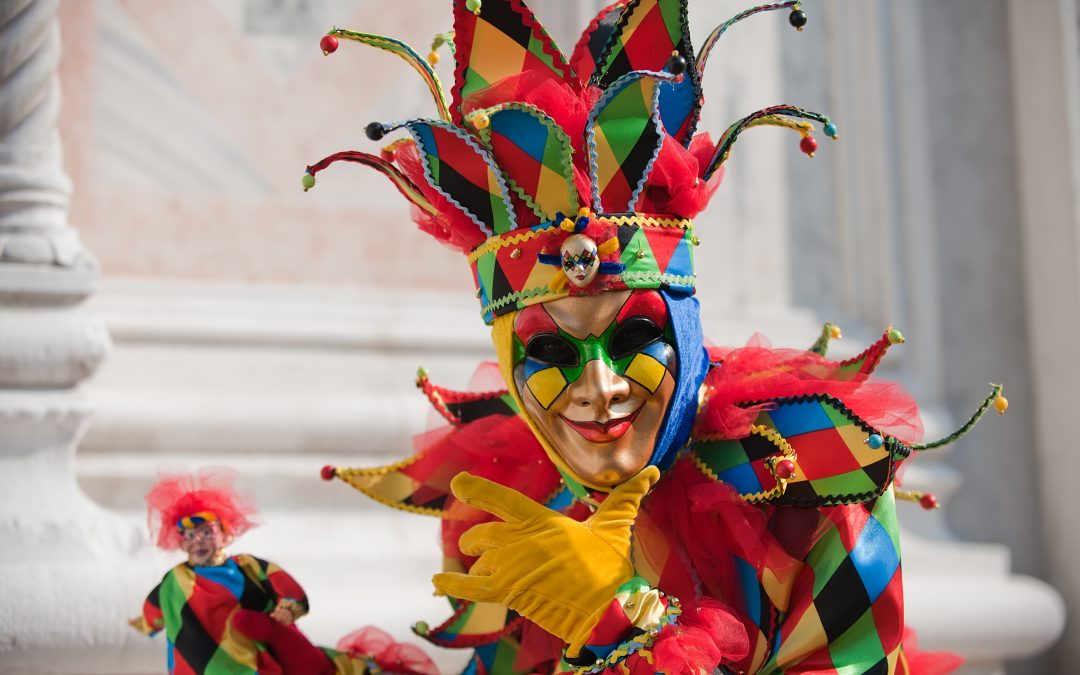Carnival in Italy is a long-standing tradition that traces its roots as far back as pre-Christian times. The word carnival is derived from the Latin term “carne vale,” literally “farewell to meat,” and represented one last celebration before a long period of self-denial, known in the Christian tradition as Lent.
During this period of fasting, eating animal products was strictly forbidden, so a huge party was held beforehand to make sure nothing was wasted. With the passing of the centuries, this annual over-indulgence has acquired plenty of other accompanying traditions, including extravagant masks, dressing up, decorated floats, and even orange throwing.
Across Italy, the parties start before Ash Wednesday and Lent, usually lasting for two or three weeks and at least one weekend before the big day of Shrove Tuesday (or Fat Tuesday—Martedì grasso). In practice, the Carnival period in Italy covers much of February and it is not unusual to see Italian kids taking the excuse to dress up in carnival costumes at any time during the first part of the year.
Carnevale in Venice
Venice carnival was first recorded in 1268 and, due to the anonymity they provided to revelers, masks have always been a central feature, with maskmakers (mascherari) enjoying an important position in society. Celebrating carnival in Venice is a once-in-a-lifetime experience that more than lives up to the hype as a buzz overtakes the whole city, locals and visitors alike.
You can hire or bring your own costume (just make sure you have a warm underlayer as February can be chilly) to take part in the fun! Venice will, of course, be very busy so book ahead. Special carnival events take place across the city on the water, from live music and canal-side parties to exclusive private balls.
Carnevale in Cento
Cento, a small town between Bologna and Ferrara, has a long tradition of carnival and is the only carnival in Europe twinned with the most famous of them all in Rio de Janeiro. Cento’s winning float is even taken to Brazil to participate the following year! People come from all over Italy to admire the floats, themed every year and still made with the same high-quality workmanship as in days gone by. If you have a sweet tooth, this carnival is the one for you, as thousands of pounds of candy, caramels, and sweets rain down on the crowds as the parade passes.
Carnevale in Viareggio
Viareggio carnival is the biggest in Tuscany and centers on the coastal town of Viareggio, about an hour from Florence. It lasts over several weekends and is known for its colorful parades and huge papier mâché puppets depicting celebrities, political figures, and animals. Some are even over 100 feet high! The jaw-dropping daytime parades are followed by all-night parties known as veglioni colorati before the evening is rounded off with a firework display. Viareggio carnival even has its own mascot, a colorful figure known as Burlamacco. Look out for his painted face and red and white costume.
Carnevale in Ivrea
The Northern Italian town of Ivrea near Turin celebrates carnival in a big way, with the largest food fight in Italy, known as the Battle of the Oranges. Thought to date back to the 12th century, this unique celebration involves thousands of locals divided into nine teams throwing oranges at each other over carnival weekend. 2023 marks the return of the battle following a break due to COVID-19. Ivrea Carnival is free to attend but non-locals who want to participate as an orange-thrower need to pay around €100 and book well ahead.
Carnevale in Rome
Carnival in Rome dates back to the Ancient Roman pagan festival of Saturnalia. Modern Carnival celebrations across the Italian capital involve theatrical performances, historical re-enactments, an equestrian parade, street art, live music, concerts, and, of course, masquerade balls. Popular carnival foods include deep-fried sugar-coated dough balls known as castagnole, flat crispy sugar-coated strips known as frappe, and bigne, a type of fluffy donut usually filled with cream. This it is not the time to be counting calories!

